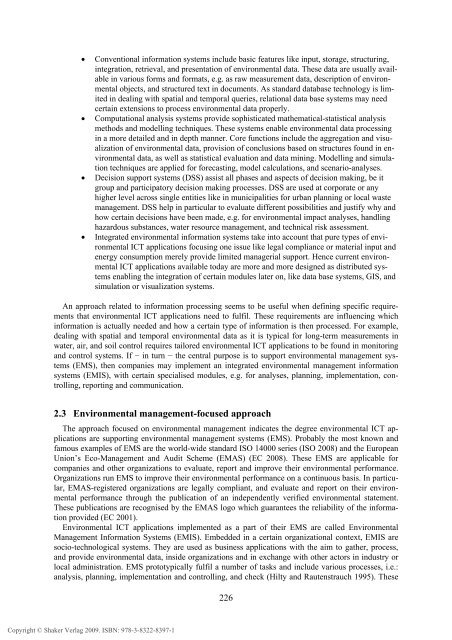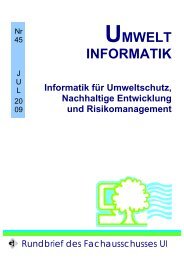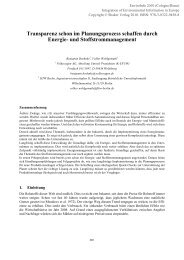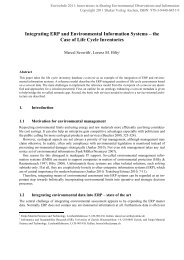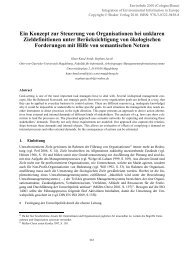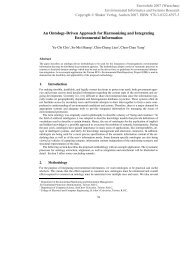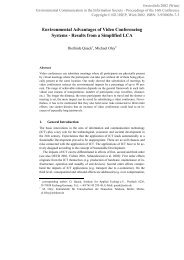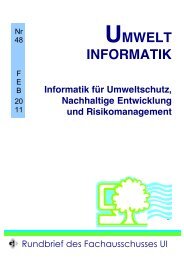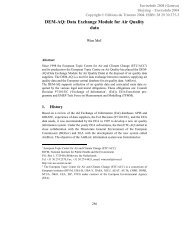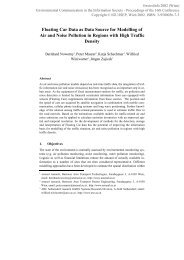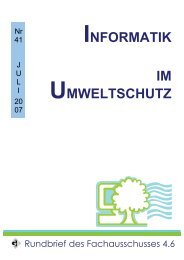Environmental ICT applications for eco-industrial ... - EnviroInfo
Environmental ICT applications for eco-industrial ... - EnviroInfo
Environmental ICT applications for eco-industrial ... - EnviroInfo
Create successful ePaper yourself
Turn your PDF publications into a flip-book with our unique Google optimized e-Paper software.
• Conventional in<strong>for</strong>mation systems include basic features like input, storage, structuring,<br />
integration, retrieval, and presentation of environmental data. These data are usually available<br />
in various <strong>for</strong>ms and <strong>for</strong>mats, e.g. as raw measurement data, description of environmental<br />
objects, and structured text in documents. As standard database technology is limited<br />
in dealing with spatial and temporal queries, relational data base systems may need<br />
certain extensions to process environmental data properly.<br />
• Computational analysis systems provide sophisticated mathematical-statistical analysis<br />
methods and modelling techniques. These systems enable environmental data processing<br />
in a more detailed and in depth manner. Core functions include the aggregation and visualization<br />
of environmental data, provision of conclusions based on structures found in environmental<br />
data, as well as statistical evaluation and data mining. Modelling and simulation<br />
techniques are applied <strong>for</strong> <strong>for</strong>ecasting, model calculations, and scenario-analyses.<br />
• Decision support systems (DSS) assist all phases and aspects of decision making, be it<br />
group and participatory decision making processes. DSS are used at corporate or any<br />
higher level across single entities like in municipalities <strong>for</strong> urban planning or local waste<br />
management. DSS help in particular to evaluate different possibilities and justify why and<br />
how certain decisions have been made, e.g. <strong>for</strong> environmental impact analyses, handling<br />
hazardous substances, water resource management, and technical risk assessment.<br />
• Integrated environmental in<strong>for</strong>mation systems take into account that pure types of environmental<br />
<strong>ICT</strong> <strong>applications</strong> focusing one issue like legal compliance or material input and<br />
energy consumption merely provide limited managerial support. Hence current environmental<br />
<strong>ICT</strong> <strong>applications</strong> available today are more and more designed as distributed systems<br />
enabling the integration of certain modules later on, like data base systems, GIS, and<br />
simulation or visualization systems.<br />
An approach related to in<strong>for</strong>mation processing seems to be useful when defining specific requirements<br />
that environmental <strong>ICT</strong> <strong>applications</strong> need to fulfil. These requirements are influencing which<br />
in<strong>for</strong>mation is actually needed and how a certain type of in<strong>for</strong>mation is then processed. For example,<br />
dealing with spatial and temporal environmental data as it is typical <strong>for</strong> long-term measurements in<br />
water, air, and soil control requires tailored environmental <strong>ICT</strong> <strong>applications</strong> to be found in monitoring<br />
and control systems. If − in turn − the central purpose is to support environmental management systems<br />
(EMS), then companies may implement an integrated environmental management in<strong>for</strong>mation<br />
systems (EMIS), with certain specialised modules, e.g. <strong>for</strong> analyses, planning, implementation, controlling,<br />
reporting and communication.<br />
2.3 <strong>Environmental</strong> management-focused approach<br />
The approach focused on environmental management indicates the degree environmental <strong>ICT</strong> <strong>applications</strong><br />
are supporting environmental management systems (EMS). Probably the most known and<br />
famous examples of EMS are the world-wide standard ISO 14000 series (ISO 2008) and the European<br />
Union’s Eco-Management and Audit Scheme (EMAS) (EC 2008). These EMS are applicable <strong>for</strong><br />
companies and other organizations to evaluate, report and improve their environmental per<strong>for</strong>mance.<br />
Organizations run EMS to improve their environmental per<strong>for</strong>mance on a continuous basis. In particular,<br />
EMAS-registered organizations are legally compliant, and evaluate and report on their environmental<br />
per<strong>for</strong>mance through the publication of an independently verified environmental statement.<br />
These publications are r<strong>eco</strong>gnised by the EMAS logo which guarantees the reliability of the in<strong>for</strong>mation<br />
provided (EC 2001).<br />
<strong>Environmental</strong> <strong>ICT</strong> <strong>applications</strong> implemented as a part of their EMS are called <strong>Environmental</strong><br />
Management In<strong>for</strong>mation Systems (EMIS). Embedded in a certain organizational context, EMIS are<br />
socio-technological systems. They are used as business <strong>applications</strong> with the aim to gather, process,<br />
and provide environmental data, inside organizations and in exchange with other actors in industry or<br />
local administration. EMS prototypically fulfil a number of tasks and include various processes, i.e.:<br />
analysis, planning, implementation and controlling, and check (Hilty and Rautenstrauch 1995). These<br />
226<br />
Copyright © Shaker Verlag 2009. ISBN: 978-3-8322-8397-1


